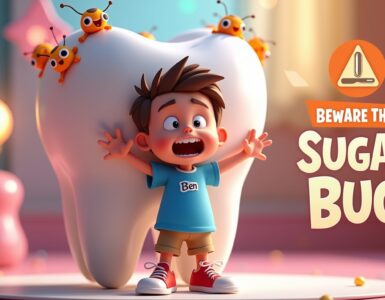Brush Brush Brush! Lyrics:
When I wake up in the morn’,
I give a big wide yawn,
Then I grab my brush and paste,
No time to waste—go on!
🎶 Brush, brush, brush your teeth,
Keep them clean and bright!
Up and down and all around,
Morning, noon, and night! 🎶
Little teeth so strong and white,
Need some love each day,
Brush them gently, left to right,
And chase the germs away!
🎶 Brush, brush, brush your teeth,
Keep them clean and bright!
Up and down and all around,
Morning, noon, and night! 🎶
Top teeth, bottom too,
Don’t forget your tongue (woohoo!)
Rinse and smile—now you’re done!
Brushing’s so much fun!
🎶 Brush, brush, brush your teeth,
Keep them clean and bright!
Up and down and all around,
Morning, noon, and night! 🎶
More: In the Forest We Go Nursery Rhymes For Kids
Master Brush Brush Brush – Your Path to Optimal Oral Health
Brush Brush Brush isn’t just a repetitive phrase—it’s a powerful mantra for maintaining excellent oral hygiene and overall well-being. In a world where daily routines can easily be overlooked, embracing the concept of Brush Brush Brush emphasizes the importance of consistent brushing practices. Whether you’re focusing on dental care, preventing common health issues, or simply building better habits, this guide delves into the multifaceted world of brushing. By mastering Brush Brush Brush, you’ll discover how a simple act can lead to transformative health benefits, backed by science and practical advice.
Understanding Brush Brush Brush
Brush Brush Brush serves as a foundational concept in personal care, particularly in the realm of oral hygiene. It represents the repetitive and thorough action of brushing, which is essential for removing plaque, preventing cavities, and promoting gum health. This section explores the core elements of what makes Brush Brush Brush effective, drawing from historical, scientific, and practical perspectives. By understanding its origins and mechanisms, readers can appreciate why this routine is more than just a habit—it’s a critical component of daily health maintenance.
Defining Brush Brush Brush
Brush Brush Brush refers to the dedicated practice of brushing teeth multiple times a day, often with an emphasis on technique and consistency. This approach goes beyond basic oral care; it’s about cultivating a mindset where brushing is intentional and thorough.
Historically, the idea of brushing teeth dates back to ancient civilizations, but the modern interpretation of Brush Brush Brush has evolved with advancements in dental science. Today, it encapsulates not only the mechanical action but also the use of appropriate tools and products to enhance effectiveness.
In contemporary terms, Brush Brush Brush is advocated by dental professionals as a key strategy to combat oral diseases. For instance, the American Dental Association recommends brushing twice a day for two minutes each session, highlighting how repetition—hence the “Brush Brush Brush” ethos—ensures comprehensive cleaning.
The Science Behind Effective Brushing
The science of brushing involves understanding how mechanical action removes bacteria and debris from teeth and gums. Brushing stimulates saliva production, which naturally neutralizes acids and remineralizes enamel, thereby preventing decay.
Research shows that improper brushing can lead to issues like gingivitis, where plaque buildup causes inflammation. By adopting a Brush Brush Brush routine, individuals can reduce these risks through consistent abrasion that dislodges harmful biofilms.
Moreover, the angle and pressure of brushing play crucial roles. Studies from dental journals indicate that a 45-degree angle to the gum line is optimal for cleaning, emphasizing that Brush Brush Brush isn’t just about frequency but also about precision to avoid damage like enamel erosion.
Common Misconceptions About Brushing Frequency
Many people believe that brushing more than twice a day is unnecessary or even harmful, but this isn’t always accurate. Brush Brush Brush encourages evaluating personal needs based on diet, oral health, and lifestyle factors.
For example, consuming sugary foods might necessitate additional brushing sessions to mitigate acid attacks on enamel. However, over-brushing can wear down teeth, so balance is key—Brush Brush Brush promotes informed habits rather than mindless repetition.
Educational campaigns often clarify that while twice-daily brushing is standard, incorporating flossing and
Master Brush Brush Brush – Your Path to Optimal Oral Health
Brush Brush Brush isn’t just a repetitive phrase—it’s a powerful mantra for maintaining excellent oral hygiene and overall well-being. In a world where daily routines can easily be overlooked, embracing the concept of Brush Brush Brush emphasizes the importance of consistent brushing practices. Whether you’re focusing on dental care, preventing common health issues, or simply building better habits, this guide delves into the multifaceted world of brushing. By mastering Brush Brush Brush, you’ll discover how a simple act can lead to transformative health benefits, backed by science and practical advice.
Understanding Brush Brush Brush
Brush Brush Brush serves as a foundational concept in personal care, particularly in the realm of oral hygiene. It represents the repetitive and thorough action of brushing, which is essential for removing plaque, preventing cavities, and promoting gum health. This section explores the core elements of what makes Brush Brush Brush effective, drawing from historical, scientific, and practical perspectives. By understanding its origins and mechanisms, readers can appreciate why this routine is more than just a habit—it’s a critical component of daily health maintenance.
Defining Brush Brush Brush
Brush Brush Brush refers to the dedicated practice of brushing teeth multiple times a day, often with an emphasis on technique and consistency. This approach goes beyond basic oral care; it’s about cultivating a mindset where brushing is intentional and thorough.
Historically, the idea of brushing teeth dates back to ancient civilizations, but the modern interpretation of Brush Brush Brush has evolved with advancements in dental science. Today, it encapsulates not only the mechanical action but also the use of appropriate tools and products to enhance effectiveness.
In contemporary terms, Brush Brush Brush is advocated by dental professionals as a key strategy to combat oral diseases. For instance, the American Dental Association recommends brushing twice a day for two minutes each session, highlighting how repetition—hence the “Brush Brush Brush” ethos—ensures comprehensive cleaning.
The Science Behind Effective Brushing
The science of brushing involves understanding how mechanical action removes bacteria and debris from teeth and gums. Brushing stimulates saliva production, which naturally neutralizes acids and remineralizes enamel, thereby preventing decay.
Research shows that improper brushing can lead to issues like gingivitis, where plaque buildup causes inflammation. By adopting a Brush Brush Brush routine, individuals can reduce these risks through consistent abrasion that dislodges harmful biofilms.
Moreover, the angle and pressure of brushing play crucial roles. Studies from dental journals indicate that a 45-degree angle to the gum line is optimal for cleaning, emphasizing that Brush Brush Brush isn’t just about frequency but also about precision to avoid damage like enamel erosion.
Common Misconceptions About Brushing Frequency
Many people believe that brushing more than twice a day is unnecessary or even harmful, but this isn’t always accurate. Brush Brush Brush encourages evaluating personal needs based on diet, oral health, and lifestyle factors.
For example, consuming sugary foods might necessitate additional brushing sessions to mitigate acid attacks on enamel. However, over-brushing can wear down teeth, so balance is key—Brush Brush Brush promotes informed habits rather than mindless repetition.
Educational campaigns often clarify that while twice-daily brushing is standard, incorporating flossing and other interdental cleaning methods can complement brushing efforts and enhance overall oral health.
Building a Brushing Routine
Creating a brushing routine might seem straightforward, yet there’s an art to doing it effectively. A structured approach to brushing can yield substantial benefits, turning a mundane task into a vital element of your self-care regimen.
Choosing the Right Tools
An effective brushing routine begins with the right tools: toothbrushes and toothpaste tailored to individual needs can make all the difference.
Toothbrush Options:
When selecting a toothbrush, consider both manual and electric options. Studies show that electric toothbrushes can remove more plaque than manual brushing due to their superior motion. Additionally, soft bristles are often recommended to prevent gum irritation and enamel wear.
Toothpaste Selection:
The choice of toothpaste should align with specific oral health goals. Fluoride toothpaste is widely endorsed for its cavity-preventing properties. However, those with sensitivity might benefit from specialized formulas designed to minimize discomfort.
Establishing a Timely Schedule
Establishing a schedule enhances the commitment to Brush Brush Brush. Consistency in timing reinforces the habit and ensures that brushing becomes second nature.
Morning and Night Rituals:
Brushing first thing in the morning helps remove plaque that accumulates overnight, while brushing before bed eliminates food particles and prevents decay during sleep. Establishing this “AM-PM” routine cultivates a proactive approach to maintaining oral health.
Setting Reminders:
Technology offers valuable solutions for establishing a routine. Smartphone apps provide reminders, offer tracking capabilities, and even guide users through proper brushing techniques.
Enhancing Brushing Techniques
Mastering your brushing technique is essential to maximize the benefits of your routine. Not all brushing methods yield equal results, so refining your approach can significantly impact your oral health.
Proper Angle and Motion:
As mentioned earlier, the ideal angle for brushing is 45 degrees to the gum line, allowing the bristles to reach below the gum tissue. Gentle circular motions help clean surfaces without causing damage.
Timed Sessions:
Ensuring that you brush for the full recommended time—two minutes—can feel tedious, but it’s vital. Using a timer or music playlists can make this process enjoyable and ensure that you’re dedicating adequate time to each quadrant of your mouth.
The Role of Nutrition in Oral Health
What you eat plays a significant role in oral health. While Brush Brush Brush focuses primarily on mechanical cleaning, nutrition complements this effort by influencing the condition of your teeth and gums.
Foods That Promote Oral Health
Certain foods can bolster your oral health and work synergistically with your brushing routine.
Dairy Products:
Foods rich in calcium, such as milk, yogurt, and cheese, contribute to tooth strength. Calcium, along with phosphates found in dairy, helps neutralize acids produced by bacteria, ensuring your enamel remains fortified.
Fruits and Vegetables:
Crisp fruits and vegetables like apples, carrots, and celery act as natural toothbrushes, scrubbing away plaque as you chew. Their high water content also aids in hydration and saliva production, promoting a healthy mouth environment.
Foods to Avoid
Conversely, some foods can compromise your oral health if consumed excessively. Awareness of these items is critical to maintaining a balanced approach to eating.
Sugary Snacks:
Sugar is a primary contributor to tooth decay, making candy and soda detrimental to your oral health. When sugar mingles with oral bacteria, it produces acids that erode enamel, leading to cavities.
Acidic Foods:
Citrus fruits, while nutritious, can also lead to enamel erosion when consumed in excess. Moderation is key—pairing acidic foods with non-acidic counterparts can help mitigate their effects.
Impact of Hydration
Hydration is often overlooked in discussions about oral health, yet drinking enough water is vital in maintaining optimal conditions for your mouth.
Saliva Production:
Water supports saliva production, which acts as your body’s natural defense against decay. Saliva neutralizes acids, washes away food particles, and contains minerals that aid in remineralizing teeth.
Avoiding Dehydration:
Dehydrated mouths can lead to increased plaque buildup and bad breath. Keeping hydrated throughout the day ensures that your mouth remains a healthy environment conducive to effective brushing.
More: Nursery Rhymes
Incorporating the mantra of Brush Brush Brush into your daily routine doesn’t merely promote good oral hygiene; it establishes a holistic approach to health that encompasses discipline, education, and awareness. By understanding the principles behind effective brushing, choosing the right tools, and complementing your routine with proper nutrition, you create an empowering system for long-term oral health. Remember, consistency is key—maintaining this routine will not only keep your smile bright but will also contribute to your overall well-being. Embrace the spirit of Brush Brush Brush, and take charge of your journey towards optimal oral health today!

















